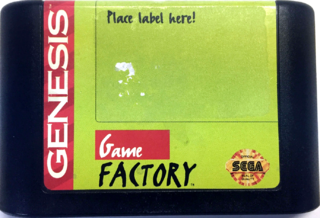Difference between revisions of "Game Factory"
From Sega Retro
| Line 30: | Line 30: | ||
Game Factory cartridges appear to use CR2032 batteries to hold onto data. Should these batteries have died in the last twenty years or more, the cartridge's contents may have been wiped, rendering them unusable. | Game Factory cartridges appear to use CR2032 batteries to hold onto data. Should these batteries have died in the last twenty years or more, the cartridge's contents may have been wiped, rendering them unusable. | ||
| + | |||
| + | ==Magazine articles== | ||
| + | {{mainArticle|{{PAGENAME}}/Magazine articles}} | ||
==Physical scans== | ==Physical scans== | ||
Revision as of 03:18, 29 August 2016
This short article is in need of work. You can help Sega Retro by adding to it.

| |||||
| Game Factory | |||||
|---|---|---|---|---|---|
| Made for: Sega Mega Drive | |||||
| Manufacturer: New Leaf Entertainment | |||||
|
Game Factory was a service offered by Blockbuster Video in the United States for a short period after 1994. It was a joint venture between Blockbuster, Sega of America and the Blockbuster-IBM project New Leaf Entertainment (and manufacturing subsidiary Fairway Technologies)[1].
The concept involved customers renting Sega Mega Drive video games stored on reprogrammable flash cartridges. Avoiding the need to stock potentially hundreds, if not thousands of official video game cartridges for rent, Blockbuster could instead use a Game Factory cartridge, flash the contents of a ROM image onto the memory inside, and distribute that instead. When the customer had finished borrowing the game, the cartridge could then be flashed with another ROM image and be recycled for further use[1].
The Mega Drive Game Factory was the first of its kind (though the concept of using reprogrammable cartridges is as old as the game cartridge itself, as it is a vital tool for cartridge game development), and was initially offered between the 10th and 15th of August 1994[1] to ten Blockbuster stores in Columbia, South Carolina. The real plan, however, was to gage interest in whether the concept would be feasible with the upcoming generation of consoles, namely the PlayStation and Sega Saturn. A Sega Game Gear variant was planned[1], but does not appear to have made it to consumers.
Blockbuster had also tried (and failed) to secure deals for other forms of entertainment, such as VHS videos and music CDs, however despite developing the equipment, big publishers were uneasy with the practise and chose not to license their libraries. Some of these fears were mitigated, however, by Viacom's takeover of Blockbuster in 1993.
Reportedly the entire system originated from reverse-engineering Mega Drive cartridges, as Sega wouldn't put their name to it until a proof of concept was created.
The process of reprogramming a cartridge took roughly 45 seconds on hardware built specifically for Blockbuster. Two types of cartrdge were offered; a "green" cartridge which could store up to 16 megabits (2MB) and a "blue" cartridge which could hold 32 megabits (4MB), both using similar plastic shells as normal retail games. The cartridge also devotes an area for a printed label, so that Blockbuster staff could easily keep track of their stock.
Though apparently a success, the Game Factory service was not rolled out nationwide, nor to other regions of the world where Blockbuster operated. Aside from the fact that Mega Drive sales were on the decline by the end of 1995, Blockbuster and New Leaf had a hard time keeping up with the demands of new games, which often included extra features that the Game Factory cartridges couldn't accommodoate.
For example, having successfully built and tested 16 megabit carts, the firm was hit with the news that Spider-Man and Venom: Maximum Carnage, a game Blockbuster had signed up to promote, would be released on a 32 megabit cartridge. Other games like Sonic & Knuckles and Virtua Racing were likely skipped entirely, and it is not known if there was compatibility with games which required a battery for saving.
Blockbuster also had trouble signing deals with third-party publishers, and so could initially only offer the service for first-party Sega games[1].
The move to optical media and the security features surrounding Saturn and PlayStation video games proved too much of a challenge for the firm, and the service was quietly discontinued at some point in 1995. It is not fully understood what happened to the Game Factory inventory - cartridges have been spotted on online auction sites, and development cartridges have also been seen. Judging by labels the cartridges may have been sold off in the late 1990s, presumably with a specific game flashed into memory.
Game Factory cartridges appear to use CR2032 batteries to hold onto data. Should these batteries have died in the last twenty years or more, the cartridge's contents may have been wiped, rendering them unusable.
Magazine articles
- Main article: Game Factory/Magazine articles.
Physical scans
| Mega Drive, US (blue) |
|---|
|